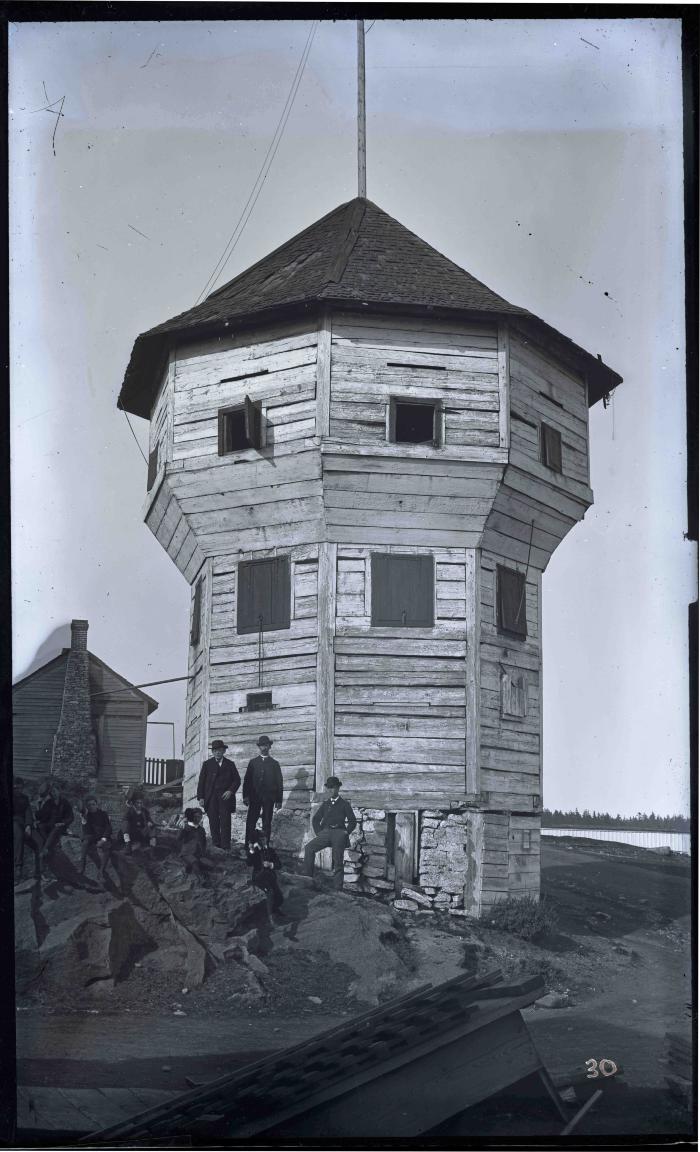negative, glass plate
Artwork
Accession Number
2016.004.001.002Description
A glass plate negative in portrait orientation depicting the Hudson's Bay Company's Nanaimo Bastion, a group of men and children standing to the left of it, a miner's cottage visible behind the group, in the foreground the terminus of the Vancouver Coal Mining and Land Company's Nanaimo colliery railway.Narrative
General Narrative for This ArtifactThis circa 1885-90 glass plate negative shows the Nanaimo Bastion (built 1853) in its original location on the west side of what is now called Front Street at the corner of Bastion Street (formerly known as Bridge Street) and one of the original Husdson’s Bay Company’s miner’s cottages. Immediately behind (north) of the cottage is another (obscured) cottage that was used by Robert and Joan Dunsmuir and their family from 1852 to 1858.
Detailed Narrative for This Artifact
According to the City of Nanaimo’s Heritage Register, the original site of the Bastion is today (year 2017) a parking lot for the Best Western Dorchester Hotel, 70 Church St. This property was formerly known as the Windsor Hotel and before that, the Villa Hotel. The Nanaimo Heritage Register states that the Bastion was, in 1891, moved east across Front Street to the ocean side of the street. The Bastion was moved again in 1974 a very short distance (less than 50 feet) to its current location on the same east (ocean) side of Front Street.
Nanaimo fire insurance maps for 1885 (Sanborn Map & Publishing Co. Ltd., New York, NY, August 1885. Rare Books & Special Collections and University Archives, University of British Columbia) and 1895 (Chas. E. Goad & Co., Montreal, 1895. Simon Fraser University Library collection) verify the accuracy of Nanaimo Heritage Register’s description of the first two locations of the Bastion.
In the 1885 Fire Insurance Plan, four Hudson’s Bay Company (HBC) wood frame buildings are shown to the right (north) of the Bastion. From left to right, the 1st, 2nd, and 4th buildings are solely dwellings (aka “HBC cottages”), while building #3 contains two offices and a dwelling space. The 1895 Fire Insurance Plan shows that HBC cottage building #4 has been replaced with a large masonry building housing the YMCA and offices. HBC cottages 1, 2, and 3 survive.
In 1852, Robert Dunsmuir brought his wife Joan and daughters Elizabeth, Agnes, and son James from Ft. Rupert to live in Nanaimo where he was to mine coal for the HBC. According to a Nanaimo Free Press newspaper story clipping held by Nanaimo Community Archives, the Dunsmuir family occupied cottage #2. The newspaper article is undated, but surmised by the NC Archives’ Daphne Paterson to have been published in either 1900 or 1919. Examination of Nanaimo Directories reveals that the article could date from as early as 1907 to as late as the early 1930’s. A druggist named Hodgins and a Collector of Customs named Good are referenced in the article, and they were active simultaneously during this period.
The story is about the display of a photograph in Mr. J.B. Hodgins’ drug store window. The photograph depicted a circa 1858 watercolour painting by Edward Parker Bedwell now held by the BC Archives (image PDP02614, see: http://search-bcarchives.royalbcmuseum.bc.ca/nanaimo-76). The article explains:
“On the extreme left of the photo, the old Bastion is to be seen, exactly in the form in which we know it today, but of the other buildings that appear in the picture, but one remains, the old wooden building adjoining the government building grounds. In all there are thirteen houses shown in the photograph. The first to the right of the Bastion was at the time occupied by Mr. John Meakin and family, some of whose descendants still reside in this neighbourhood. Working to the right the next house was that occupied by the late Robert Dunsmuir, the founder of the fortunes of the family of that name. Then came Dr. Benson’s residence while the next was occupied by Daniel Dunn and his wife”.
The article mentions a total of 13 cottages in the front row. Careful examination of the actual painting reveals a total of 14 cottages in the front row on what would eventually become known as Front Street. Maps from the period confirm the number at 14 (see: Plan of Colvile Town by Joseph Despard Pemberton, 1853. HBC Archives G1/258 (h) (Detail) as published in Derek Hayes, British Columbia, a New Historical Atlas (Vancouver/Toronto/Berkley: Douglas & McIntyre Ltd.) 224, and; Plan of Nanaimo by F. W. Green, circa 1861. HBC Archives C1/142 (detail) as published in Derek Hayes, British Columbia, a New Historical Atlas (Vancouver/Toronto/Berkley: Douglas & McIntyre Ltd.) 224-245). The article lists the occupants of the first 4 cottages working from the right of the Bastion. These same 4 cottages are shown clustered in the 1885 Fire Plan. Examination of the actual painting suggests there were 5 cottages in the front-row cluster, with the 1st one situated very close to the Bastion. These 5 cottages were probably rendered out of true perspective by the artist. The 2nd cottage is depicted as being in the position that various historic maps show was the site of the 1st cottage.
A more accurate depiction of building siting is seen in historic maps. Pemberton’s 1853 map of Colvile Town (later named Nanaimo) does not show a building to the immediate right of the Bastion, but rather, it essentially shows what is depicted in the 1885 Fire Plan – namely, a cluster of 4 cottages, with cottage #1 farther away from the Bastion than is shown in the Bedwell painting. The missing piece of paper/linen in the 1853 Plan of Colvile Town would have probably shown the entire 3rd cottage, not just the smidgeon of it which is evident on the map. Also, if the missing piece of paper/linen was there and depicted all of cottage #3, there would be a total of 14 cottages/buildings in a straight line. The existence of 14 buildings in the front row of cottages/buildings is further confirmed in F. W. Green’s circa 1861 Plan of Nanaimo.
In an attempt to identify both the Dunsmuir cottage and the cottage depicted in the glass plate negative (2016.004.001.002, analysis of historic photographs was undertaken. The earliest known photograph of the area of interest is held by Royal BC Museum, BC Archives (Image A-40446, see: http://search-bcarchives.royalbcmuseum.bc.ca/nanaimo-87). With the camera lens pointing in an easterly direction, it shows two of the four cottages nearest the Bastion, and both of them have single chimneys protruding from the centre of their roofs. The cottage nearest the Bastion is cottage #1, and it was altered soon after this photo was taken so that there was a chimney at each side of the cottage. Another possibility is that this 1st cottage was destroyed and replaced on the same spot by one with two chimneys soon after this picture was taken.
Next, an 1858 photograph (Image A-04417 courtesy Royal BC Museum, BC Archives, see: http://search-bcarchives.royalbcmuseum.bc.ca/nanaimo-part-b-see-04416-to-04420) taken at the same angle, but from a higher elevation, shows the same cottage #1 with one chimney protruding from the middle of the roof. To its left are cottages #2, #3, and #4.
Next is an image dated 1867 by City of Vancouver Archives (CVA AM54-S4 Out P236) which clearly shows cottage numbers #1, #2, #3, and #4. Cottage #1 has a chimney at each side of the building. Cottage #1 is an altered version or replacement of the original cottage #1.
Similarly, a City of Vancouver Archives image dated at 1860’s (A-6-117) shows cottage #1 with a chimney at each side of the cottage, whereas cottage #2 has one chimney coming from the middle of the roof. Cottages #3 & #4 are clearly visible.
An 1875 photograph (Image A-04422 courtesy Royal BC Museum, BC Archives, see: http://search-bcarchives.royalbcmuseum.bc.ca/nanaimo-99) shows cottage #1 is whitewashed. The stone chimney on the south wall is clearly evident is also whitewashed. Cottage #2 has one chimney in the centre of the roof.
Aside from the number and location of chimneys, windows and doors were distinguishing characteristics of Nanaimo HBC cottages. Craigdarroch’s Curator examined relevant original historic photographic prints at BC Archives. BCA B-01432, dated circa 1883, shows that cottage #1 had a window/door/door/window configuration, indicating that it probably had a duplex floorplan. This may or may not have been the original layout. Cottage #2 was a window/window/door/window configuration, indicating that it was single family floorplan. Based on the fact that the single chimney in the middle of the roof of cottage #2 remained unchanged in all photographs, it is reasonable to conclude that this cottage was always for a single family to live in.
Close examination of 2016.004.001.002 shows the cottage has a rubble-stone, brick-topped chimney. To the left of the chimney where the brick courses commence, is a visual hint that a similar chimney is protruding from the opposite side of the structure. Two clapboards are missing from the structure, revealing what is probably the original hewn-log structure. The cottage depicted in 2016.004.001.002 is almost certainly HBC cottage #1. Cottage number #2 was occupied by the Robert Dunsmuir family and John Muir. It was demolished in 1910 when the Windsor Hotel expanded: Nanaimo Free Press, February 14, 1910 page 1,
“New Wing To Be Added to Windsor Hotel…The plans involve the building of a large wing on the south side of the building… The alterations will result in the disappearance of an old and interesting landmark of this City, namely the old Dunsmuir residence. It was in 1853 that the late Mr. Robt. Dunsmuir came down from Fort Rupert with his family, and their first residence was in this house behind the Windsor Hotel, which the increase in business in the City has now doomed to extinction. For five years the Dunsmuirs occupied this house, the Hon. James Dunsmuir being at that time a boy. In 1858 Dunsmuir the elder put up a log house on the corner of Wallace and Albert, on the lot which now stands the residence of Mark Bate…”
Nanaimo Free Press published another story on August 1, 1911 stating of the Dunsmuir cottage: “…Their first house was a miner’s cottage on Front Street where son Alexander was born. It was torn down only last year”. That the Dunsmuir cottage was demolished to make way for the new Windsor Hotel wing is further substantiated in Carroll, H. History of Nanaimo Pioneers, Nanaimo: Herald Presses, 1935, p.69. Its demise is further supported through comparison of the 1885 Fire Insurance Map and a modern satellite photograph of the site.
The two men and six boys in 2016.004.001.002 are unidentified. The group might be a school class, boys’ club, or church gathering. The boys are particularly well-dressed.
Nanaimo historian Lynne Bowen’s keen interest and relentless sleuthing provided information critical to the verification that 2016.004.001.002 depicts the miner’s cottage immediately to the south of the Dunsmuir cottage. Daphne Paterson of Nanaimo Community Archives was also of considerable assistance in understanding 2016.004.001.002. The Castle Society gratefully acknowledges their assistance.
History of Use
unknownDate
circa 1885 – 1890Dimensions
0.5 cm x 20 cm x 13 cmPhotograph Type
Gelatin silver processSubject/Image
Nanaimo Bastion and miner's cottageMedium
PhotographicSupport
GlassCountry of Origin
CanadaRelated Objects
negative, glass plate, 2016.004.001.001 (is related to)



